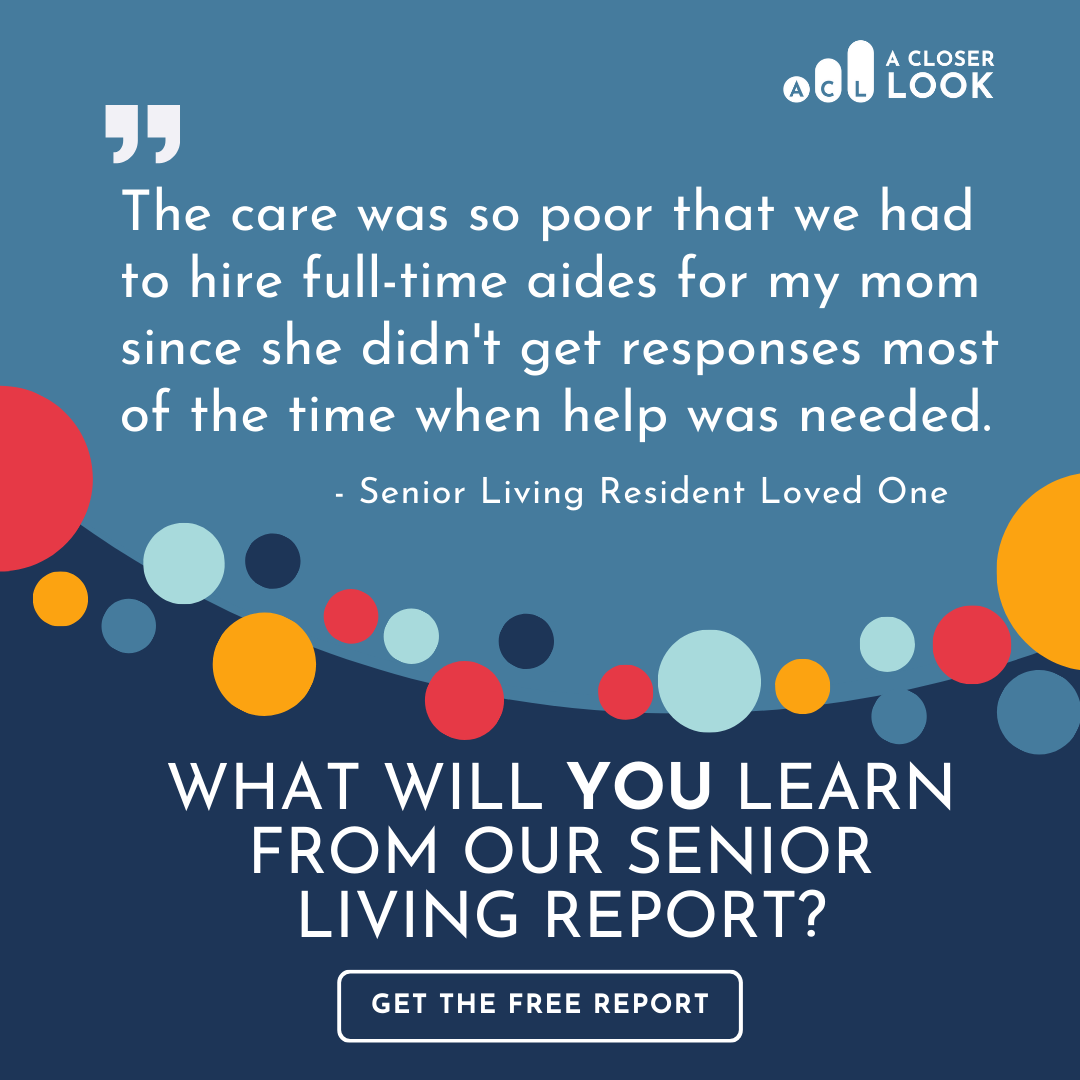
Exploring Concerns and Considerations in the Senior Living Landscape: A Closer Look’s Independent Research
Introduction
The senior living landscape is undergoing a significant transformation as the aging baby boomer generation continues to shape the demographic landscape. With the demand for senior living options on the rise, it is crucial for senior living communities to understand the concerns and considerations of potential residents and their families.
Concerns and Considerations
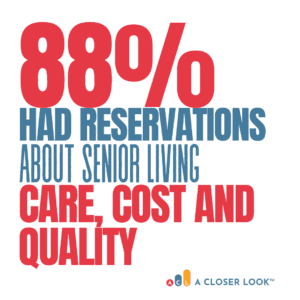
1. Caregiver Support: One significant concern expressed by survey respondents was the perceived lack of supportive caregivers within assisted living communities. Many expressed concerns about high turnover rates among caregivers, as well as caregivers being unsupportive or indifferent towards residents’ needs. Instances of slow response times for essential tasks, such as changing diapers or bed linens, were reported, causing discomfort and inconvenience to residents. One respondent shared their experience, stating, “When my mother’s physical needs became too much for us to handle, we had to put her in assisted living. The care there was so poor that we had to hire full-time aides to be in the apartment with her since she didn’t get any response most of the time when she needed help.”
2. Staff Qualifications: Participants also expressed concerns about the qualifications and expertise of staff members in assisted living communities. There was a prevailing perception among those surveyed that caregivers often lacked the necessary skills and training required to provide adequate care to residents. Many respondents felt that staff members were underpaid, leading to a higher prevalence of individuals working multiple jobs to make ends meet. The perceived lack of respect for the caregiver position resulted in less qualified individuals applying for available openings. As one respondent summarized, “Assisted living can be a lifesaver or a life ender depending on the staff.”
3. Neglect or Abuse: Disturbingly, some survey respondents reported instances of neglect, abuse, and property theft by caregivers within assisted living facilities. These accounts raised significant concerns about the safety and well-being of residents under their care. One participant shared an alarming incident, stating, “A family member was left on a toilet for over an hour until they got up themselves and fell.” Survey participants believed that there was insufficient monitoring and supervision of caregivers, potentially leading to subpar care or misconduct.
4. Quality: The overall quality of services, facilities, and living conditions emerged as another major concern among survey respondents. Issues raised included cleanliness and hygiene standards, lack of amenities, and unmet expectations. Surprisingly, over 300 of those surveyed specifically commented on bland, tasteless food or poor-quality meals. A recurring theme was the presence of a urine or bleach odor throughout the communities. One respondent shared their experience, “I have experience with several assisted living communities, and the staff have been very caring, overall. However, the pay is not good and staff retention and continuity is a problem. Also, it seems like the residents sit unattended for long periods of time without engagement, stimulation, or involvement in activities. The atmosphere in these communities isn’t always clean, fresh, or inviting. The food is not freshly prepared with clean ingredients; rather, it resembles food from a box or can or frozen.”
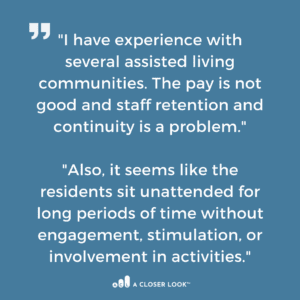
5. Profit-Driven Operators: Respondents expressed skepticism regarding the motivations of some assisted living operators, perceiving them as primarily driven by financial gain rather than genuinely caring about residents’ well-being. This perception created doubts about the operators’ commitment to providing quality care and raised concerns that they might only meet minimum requirements. One respondent stated, “Though residents pay a premium price to live there, the vast majority of facilities pay very low wages to the caregivers and often only have one licensed nurse (LPN or RN) on staff.”
Exemplary Communities and Resident Preferences
Despite the concerns raised, a significant number of survey respondents acknowledged that certain senior living communities stand out by providing exceptional service and care. These communities offer attractive features such as:
- restaurant-style dining
- a wide range of amenities
- extra safety features
- a high staff-to-resident ratio
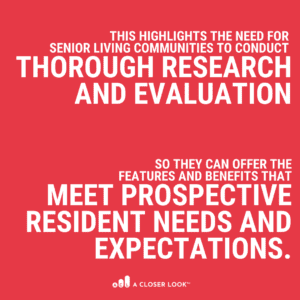
Cost as a Deterrent
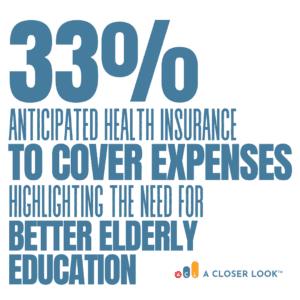
Alternatives to Assisted Living
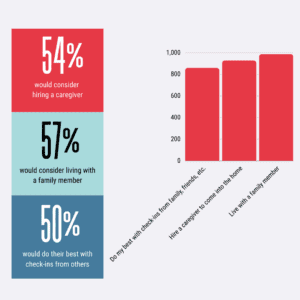
Addressing Concerns: Best Practices for Senior Living Operators
1. Improve Caregiver Support: Senior living communities must prioritize hiring and retaining well-trained caregivers who genuinely care about residents’ well-being. This can be achieved by offering competitive wages, providing ongoing training and professional development opportunities, and implementing support programs for caregivers to prevent burnout.
2. Enhance Staff Qualifications: It is essential for senior living communities to ensure that their staff members have the necessary qualifications, skills, and training to provide high-quality care. Regular assessments, performance evaluations, and educational opportunities can help maintain and improve staff competence.
3. Strengthen Oversight and Monitoring: Implementing robust oversight mechanisms, such as increased supervision, regular audits, and anonymous reporting systems, can help detect and prevent instances of neglect, abuse, or misconduct. Clear protocols should be in place to address complaints and take appropriate action when necessary.
4. Prioritize Quality: Senior living communities should focus on providing excellent services, maintaining high cleanliness and hygiene standards, offering nutritious and appetizing food, and ensuring that residents have access to engaging activities and socialization opportunities. Regular feedback from residents and their families can help identify areas for improvement.
5. Increase Transparency: Senior living communities should be transparent about their pricing, services, and quality standards. Providing clear and detailed information upfront can help potential residents make informed decisions and avoid surprises or disappointments after moving in.
6. Advocate for Affordable Options: There is a need for greater advocacy to make senior living options more affordable and accessible, particularly for middle-class citizens. Collaborating with policymakers and healthcare providers to explore potential financial assistance programs or insurance coverage can help alleviate the cost burden for seniors and their families.
Research Strategies for Senior Living Operators
Research Tactics to Consider
- Independent, anonymous phone and/or web evaluations
- In-person community visits and/or in-person tours
- Unannounced assessments for quality of food + dining experiences
- Evaluation of caregiver recruitment process to ensure responsiveness of HR teams
- Comprehensive competitive analysis to understand industry benchmarks + best practices
- Text surveys to gather data from post-tour prospects
- Anonymous feedback collection + management from residents and family members
- Surveys + focus groups targeting seniors and their adult children to gain valuable insights
For More Information
For assistance collecting first-party data and analyzing the insights about your prospective residents and their families, contact A Closer Look.